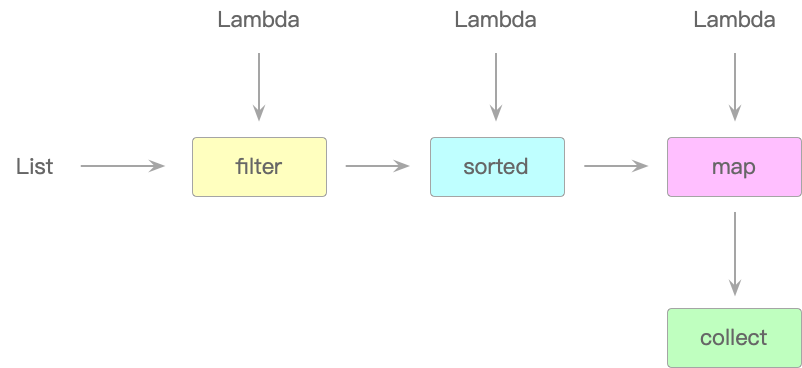您好,我是湘王,这是我的博客园,欢迎您来,欢迎您再来~
Lambda表达式虽然将接口作为代码块赋值给了变量,但如果仅仅只是Lambda表达式,还无法让Java由量变引起质变。真正让Lambda能够发挥出巨大威力的,就是流式计算。
所谓流式计算,就是让数据像在流水线上一样,从一道工序流转到下一道工序。就像这样:

如果把数据处理的方式比作流水线,那么Spark、Storm和Flink就是目前市面上头部的三家工厂。它们有各种各样的数据装配间(也就是各种处理数据的算子),将数据按照所需加工成型。所以,不懂流式计算根本就做不了大数据开发。上面那张图,如果换成流式计算的,就是这样:

Lambda表达式就变成了一个个的数据装配间。
还是以实际的代码例子来说明。假如有这样的代码:
/** * 雇员数据 * * @author 湘王 */
public class Employee { public enum Type { MANAGER, SELLER, OFFICER }; private String name; private String genger; private Integer age; private boolean married; private Type type; public Employee(final String name, final String genger, final Integer age, final boolean married, final Type type) { super(); this.name = name; this.genger = genger; this.age = age; this.married = married; this.type = type; } public String getName() { return name; } public void setName(String name) { this.name = name; } public String getGenger() { return genger; } public void setGenger(String genger) { this.genger = genger; } public Integer getAge() { return age; } public void setAge(Integer age) { this.age = age; } public boolean isMarried() { return married; } public void setMarried(boolean married) { this.married = married; } public Type getType() { return type; } public void setType(Type type) { this.type = type; } @Override public String toString() { return this.name + "(" + this.genger + ")-" + this.age; } }
如果想筛选28岁以下的员工,并按年龄排序,用老办法只能这么做:
List<Employee> employees = Arrays.asList( new Employee("张勇", "男", 28, true, Employee.Type.MANAGER), new Employee("李强", "男", 22, false, Employee.Type.SELLER), new Employee("王武", "男", 32, false, Employee.Type.SELLER), new Employee("梅丽", "女", 26, true, Employee.Type.OFFICER), new Employee("郑帅", "男", 29, false, Employee.Type.OFFICER), new Employee("曾美", "女", 27, true, Employee.Type.SELLER), new Employee("郝俊", "男", 22, true, Employee.Type.SELLER), new Employee("方圆", "女", 24, false, Employee.Type.SELLER) ); // 传统筛选数据的方法 // 筛选28岁以下的员工
List<Employee> list1 = new ArrayList<>(); for(Employee employee : employees) { if (employee.getAge() < 28) { list1.add(employee); } } // 按年龄排序
list1.sort(new Comparator<Employee>() { @Override public int compare(Employee o1, Employee o2) { return o1.getAge().compareTo(o2.getAge()); } });
如果要转换成Lmabda表达式的话,就是这样:
/** * 雇员函数式接口 * * @author 湘王 */ @FunctionalInterface public interface EmployeeInterface<T> { boolean select(T t); } public static List<Employee> filter(List<Employee> employees, EmployeeInterface<Employee> ei) { List<Employee> list = new ArrayList<>(); for(Employee employee : employees) { if (ei.select(employee)) { list.add(employee); } } return list; } // 使用Lambda表达式得到28岁以下的员工
List<Employee> list2 = filter(employees, employee -> employee.getAge() < 28); // 按年龄排序
list2.sort((e1, e2) -> e1.getAge().compareTo(e2.getAge()));
可以看到,这虽然用了Lambda表达式替代了旧的方法,但可能要写大量的函数式接口,Lambda沦为鸡肋,完全谈不上简便快速,更别说优雅!
所以,这时候如果用流式计算,那简直不要太优雅:
// Lambda表达式 + 流式计算
List<Employee> list3 = employees // 生成「流」
.stream() // 过滤
.filte